|
|
|
|
By Request --ESD 81692
Another deluxe fully-restored edition
Available for the First Time on CDOptimum 20-bit Hi-D transfers from the original 1975 master mixes, cleaned and tweaked to a fare-thee-well. This is the best this album has ever sounded. Includes the complete featured composition, Pompous Circumstances.
|
THREE DANCES FROM
"NUTCRACKER
SUITE" |
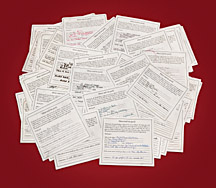 |
Little did we realize what we were getting ourselves into
in 1971, when Rachel Elkind and I asked CBS Records to place a
prepaid business reply card inside the package of each newly pressed
album. These 6-inch by 7-inch white cards solicited some needed
feedback from our early listeners. The message on the rear side
requested (in an attractive calligraphy) that listeners use the
provided blank lines to write their ideas and comments to send back
to us. Would anyone care enough to respond?
CBS reluctantly agreed to the idea, initially for a six month
trial period. The cards proved popular, and were continued for five
years. Embarrassingly, the top line ungrammatically read: "Please
mail me quick!" Perhaps that sounded "hip and with it" in those days
when one could find a flower in every ear, part of letting it all
hang out, or whatever else seemed groovy. It must have struck the
right tone all right, for the return stack grew from inches to a
boxfull.
The need for feedback shouldn't be underestimated. Most other
recording artists regularly appear in live performances. One can
learn a great deal from an audience, how well you're communicating,
where to cut or expand. Since we were forced to work note-by-note,
phrase-by-phrase with the clumsy Moog synthesizer, the proceedings
would have been ludicrously dull in a concert hall. Those early units
were also frustratingly unstable and unpredictable. Work with such
tools was both clumsy and slow. Imagine a cross between a juggler
trying to spin a dozen plates on wooden poles, and Disney style
animators drawing their individual frames -- an essay in gentle,
careful tedium, yielding magic only after the long process is
fine-tuned and complete.
Glenn Gould, the brilliant iconoclast Canadian piano virtuoso
who generously championed our electronic realizations, was delighted
to abandon live performances just about the time we would have
greatly benefited from a few of them. By then Glenn had experienced
years of audience feedback (which he neither needed nor enjoyed).
Pioneering a brand new medium is a very different experience from
grand performances on a grand piano.
The analogy with animation is apt. You can quickly lose your
way over hours and days, your focus wanders, while you wonder if what
you're accumulating is worth the effort and time. The Disney artists
constantly interact with one another, their directors, and other
members of a creative team. We had no team, and few others we could
call upon for perceptive help, people who would also be neutral, and
willing to risk offending us.
Thus the idea of those prepaid cards was born, and proved to
be quite good. At least we did get a significant response. A problem
arose. Opinions frequently aimed in exactly opposite directions. When
only our first two albums were available, folks mainly asked for more
Bach and Baroque. When we got to where I'd been heading--my own
original music, folks began begging for more of that, too. Once Sonic
Seasonings and our score for Kubrick's Clockwork Orange joined the
others, the cards covered a broader range. We'd often smile to read
two adjacent cards, the first requesting: "more Bach", the next
urging: "less Bach, more original music." Got it.
Other composer's works were suggested. Big orchestral
potboilers were common, belying the difficulties and enormous time it
took with a limited monophonic instrument and a single 8-track
recorder to achieve even the polyphony of a small ensemble. The press
was partially to blame, supporting misconceptions that this clumsy
medium was quick, easy, and even automatic. After all, many early
photos of Moog synths focused on the few blinking lights, minimized
the keyboards, controls and manual interaction, implying it was some
kind of computer, thus it HAD to be automatic, right? Myth and
romance still surround the "Moogs." You'd be shocked at what an
awkward, overrated device it was to perform expressive, graceful
music on!
In the end, if I was going to spend months for mere minutes of
music, I certainly wasn't going to be pigeonholed into only
retreading existing music, when: 1) I'm not that slick a performer,
2) this limited us to transcriptions, not music written for the new
medium, and 3) I'm not a half-bad composer. Other reply cards were
more helpful, politely requesting more of our musical use of stereo,
certain sound families and effects, increased exotic, novel timbres,
big theatrical passages, and even that we overlay vocals, chorus, and
instrumental soloists -- all fine ideas (thank you!).
We started exploring many of these suggestions, working
several into other projects we'd already begun, redirecting new
ideas, reworking old ones. It was liberating, and also highly
eclectic, as one might expect. With this medium still in its infancy,
this was no time to be dogmatic about what was proper, and what was
off-limits...
(Read the complete notes in the By Request CD
booklet.)
--Wendy
Carlos
New York City, September
2002
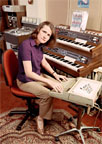 |
After issuing Switched-On Bach, TEMPI Productions and
Columbia Masterworks were continually bombarded with repertory
suggestions from interested listeners for future Wendy Carlos
records. Bewilderingly diverse as a list of these suggestions might
seem, Wendy and Producer Rachel Elkind anticipated a surprising
variety of them by many years; wide-ranging as they are, they only
begin to cover the amazing scope of Wendy's uniquely heterogeneous
musical interests.
Though specialization these days has become even more drearily
respectable in the Arts than in the Sciences, Wendy has always
resolutely refused to typecast herself. "Pigeonholes," she says, "are
just fine--for pigeons." Citing Mozart, Beethoven, Brahms,
Stravinsky, Copland, and others too numerous to mention, she claims
that a true professional should be able to make good music in a great
number of different styles, and in give-and-take with a great many
other musicians. She finds that collaboration gives her a valuable
parallax on her solitary work. Her most recent such partnership,
indeed, with Rachel Elkind, sometimes approaches creative symbiosis,
for Wendy is extremely sensitive to the integrity and essential
character of a collaborator's ideas, and has the humility to take a
subordinate role when the project warrants it.
Wendy's serious compositions have been much in demand by
listeners. As might be suspected from her broad focus of interests,
they cheerfully make use of the whole range of 20th-century styles.
Her experiments in the popular genre constitute only a small
percentage of her development. She has long cherished the idea of
devising a proper format for the publication of the best of her
lighter work. This record, then, contains, in addition to much that
is brand new, examples from nearly every period and style of her
career, all newly re-mixed, some discretely revised and edited. It
can truly be said to grant the requests not only of thousands of
listeners but also of Wendy Carlos herself.
The three "Nutcracker" dance transcriptions are Wendy's first
attempts at major romantic repertory. One would never suspect, from
listening to these, that the rich plushness of sound and the rhythmic
flexibility demanded by Tchaikovsky's music are qualities singularly
ill- suited to the basic personality of the synthesizer. Maintaining
clarity of texture and tight ensemble through the mixing and
sub-mixing of 40 tracks and 62 separate parts would seem to be a
nightmarish task. Yet what first struck me about these performances
was their high spirits, the unforced suppleness of their phrasing,
and the naturalness of their rubatos, ritards, and accelerandi.
Without exaggeration, they can be said to represent the state of the
electronic art.
"Dialogues for Piano and Two Loudspeakers" and "Episodes for
Piano and Electronic Sound" are pre-synthesizer pieces dating back
about a decade. ("Dialogues," from 1963-1964, is, in fact, the
earliest composition Wendy still acknowledges.) Because every note
had to be separately recorded and spliced, most composers of that
period were content to assemble impressionistic collages of sound,
relying heavily on makeshift time-savers such as tape loops, speed
manipulation, echo chambers, and ring modulators. Wendy was almost
alone in composing clear polyphony.
A comparison of these two pieces with her most recent work
reveals, of course, ten years of technical progress. Still, the
earlier pieces exhibit a lively awareness of the expressive problems
of electronics. In both, the piano not only provides total contrast
but also imparts to the electronic portions an illusory rhythmic
"spring" and spontaneity. Pianist Phillip Ramey's understanding of
this special stylistic requirement deserves high praise, indeed.
Wendy chose to emphasize the granitic rhythmic severity by a
certain implacable, even dour, character in most of the themes of
"Dialogues." To this, the accelerating rising scale theme halfway
through (seven pieces of tape ranging from seven inches down to one
inch long) provides impudent contradiction, provoking the final
conflict. "Dialogues," incidentally, is an example of Wendy's
periodic use of serial organization. The interval series from which
the materials grow is presented, untraditionally, near the very end
of the piece in a building chord of electronics, just before the
final splash of piano arpeggios.
"Episodes" attempts a wider expressive palette: The themes
are, by turns, more wistful and more romantic, the piano writing is
far more virtuosic. Completed at the Columbia-Princeton Electronic
Music Center (where "Dialogues" was wholly composed), "Episodes" was
largely realized in Wendy's improvised basement studio at her
parents' Providence, Rhode Island, home in the summer of 1964.
More recently, noticing that certain ratios of the geodesic
could be "translated" into extremely subtle dance rhythms, Wendy
composed the fragmentary "Geodesic Dance," which was also an
experiment in quadraphonic spatial locations...
(Read the complete original notes in the By Request
CD booklet.)
--Benjamin
Folkman
 |
Up until this new edition a story has waited to be told -- one about a most frustrating event which occurred during the original release of By Request. If CBS records had not been so timid, stickers like the one you see above would have appeared on those first LPs and cassette tapes proclaiming the somewhat surprising and unfortunate news. By Request's featured composition, Pompous Circumstances, had been yanked from all copies pressed and sold in the British Commonwealth, due to a botched communication in London when the album was about to go to press. Wendy tells the amusing, and no so amusing sides of this story in the new CD's booklet. For fans in England who may have wondered about the expurgated copies which were made available there, this sad tale will hopefully set the record straight. We'll also include this sticker on our new CD editions, a near three decade late announcement of "full disclosure."
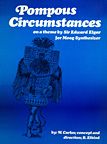 |
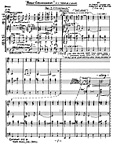 |
Included in the Enhanced CD files for
By Request is something quite
unusual, and we think, rather special. Above you'll see snapshots of
the cover and first page of a very limited edition of the full score
to the featured track on the album, Pompous Circumstances. This
edition was prepared for TEMPI by G. Schirmer & Sons, the
renowned classical music publishing firm, during the 1975 initial
release of By Request on CBS records. Only 200 copies were printed,
which were sent to music reviewers and editors, in addition to a few
surprise gifts to those who had been helpful during the album's
production. All of these copies have long since vanished. But one
protection copy was retained by Wendy, carefully stored in mint
condition.
For this deluxe edition of the album we thought many of you
would enjoy the chance to study the score alongside the digitally
remastered audio. Careful scans were prepared of 12 selected pages
from the full score, and are included in the enhanced files, along
with a complete musical analysis of the work by composer and former
editor of the NY Philharmonic program guide, Phillip Ramey. Ramey's
liner notes graced many classic music albums on CBS during a span of
20 years. You'll find other bonus material also included within these
computer readable files, as we've done for all of our ESD remastered
editions.
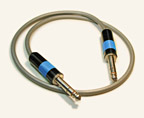 |
There's a mixed blessing in confronting the relics of one's
past, especially one's creative works. Yes, we all do evolve during
our lives, mostly in gradual adaptation to the real world we face
daily. Yet unless we are actually bipolar, most of us find a
continuity. Hopefully our appreciation of great foods and the arts
expands, and it usually seems to. Yet as a musician I still find my
pulse quickens upon hearing some of the masterworks which excited me
early on: works by Ravel and Bartok, Beethoven and Brahms, Ellington
and Davis, Stravinsky and Respighi.
When I face my own earlier creations I find myself
slightly torn by hearing something I once knew intimately more afresh
than I could while composing and performing the original. There's
greater perspective with time. And for the better relics from one's
own heart and mind, you can appreciate the good ideas more
objectively much later on.
By Request was by its concept a
wildly eclectic collection of music of many kinds. With the media and
recordings available even several decades ago, it was pointless to
think one could avoid being exposed to a much broader pallet of
musical styles and ideas than an earlier generation of composer would
face. You could try to deny it, but it remained in your
subconscious.
I love the ability to skip over time and style and medium
through very different kinds of music, ethnic and historic, leaping
gaps without much effort. So By
Request does jump around, more than any single album
normally ought to, but that is it's whole point.
While we were collecting selections, Rachel and I thought we
might try to constrain one side of the stereo LP as mostly "serious"
music, the other as mostly "pop," more or less (the master tape reels
still are so marked). It's not hidden: the first half of this CD,
still in the same track order as the original LP editions, IS mostly
classical, while the second half flits about with pop and jazz ideas
more than any other album I've worked on.
While remastering the music, I've been recalling how some of
the music had been put together, or why other selections had grown
into replacements for a prior idea which had not worked out well.
Informally, let me share some of these thoughts with you here.
The Nutcracker selections
were realized before the synthesizer could manage a rich late
romantic style of orchestration. It was ill-suited for the changing
tempi, legato phrasing, and tall stacks of instrumental parts. Each
line had to be hand played on its own individual track, often upwards
of 40 to 50 of them. You stick with that kind of challenge mostly to
prove that you can. Later you avoid doing it again, until the
instruments finally catch up. By now most of this kind of synthesis
can be done with far less effort.
Back then, you first had to construct a careful click track,
containing what you hoped would map out the way a fine conductor
would react to the sounds, musical lines and forms. But you couldn't
hear those until it was way too late to do much about any
miscalculations, short of starting all over. Even I find it hard to
accept that we willingly tried to make music in such a clumsy manner.
But gradually new tools were developed to make a studio composer's
and musician's job a lot more straight-ahead...
(continued on By Request's additional
Enhanced-CD files, as explained below).
--Wendy Carlos
|
Important
Note: In summary, the path for the
added new
notes (from the
WC-BR-ECD
folder) is:
|
By Request was recorded originally on a 16-track 2" (3-M model M-56) tape machine using Dolby A, then mixed to Dolby surround premasters on four-track 1/2" Ampex. The mixes were edited and reduced to two track final masters using equalization and level optimization appropriate to the LP technology of the day. Several older tracks were originally recorded and mixed to two track stereo. For this new edition we began with the first generation premasters. This meant we could make an optimum Hi-D 20-bit transfer without any of the previously needed compromises. All tracks were next meticulously fine-tuned, cleaned and optimized, as with the other ESD masters in this series. You may rest assured that this is the best these recordings have ever sounded.
This
Special Edition of By
Request was
assembled by Wendy Carlos, including the spiffy new album cover.
Graphics mix by Drew Miller; layout, texts, illustrations and images
by the composer. Photo of Wendy Carlos by Venon Smith.
Remastered by Wendy Carlos,
with thanks to John
Romkey and Mike Burg, for computer equipment and frequent support, to
Clare Cooper for assistance during master transfers, to Eric Klein
for Bias Peak and Waves software, to Joe Winograd and Gabriel
Lawrence @ Aris for MusiCode support, to Drew Miller@ ESD for the
Enhanced-CD file assembly and HTML editing, and to ESD's Rob Simonds
for thoughtful suggestions, feedback, and executive support.